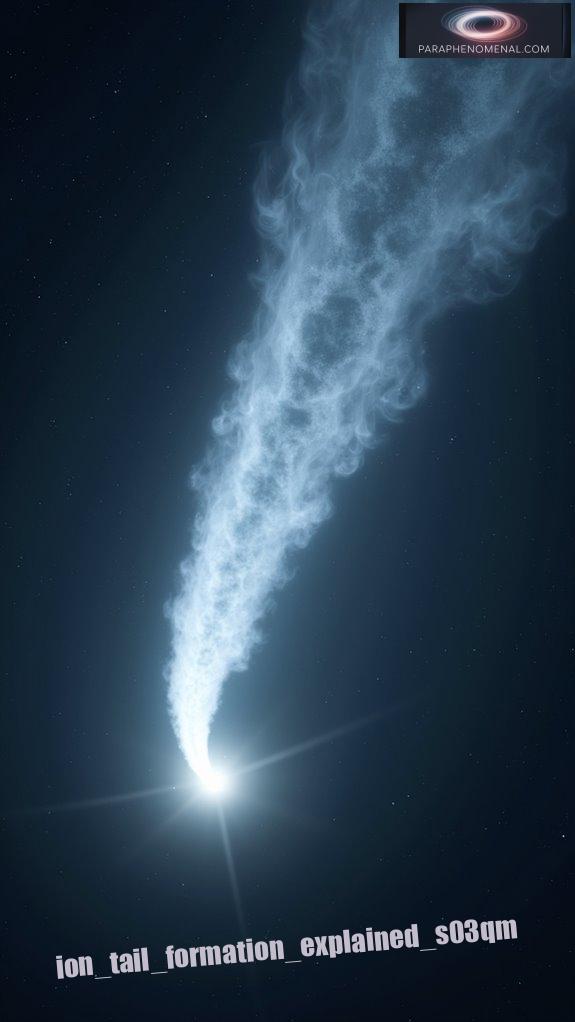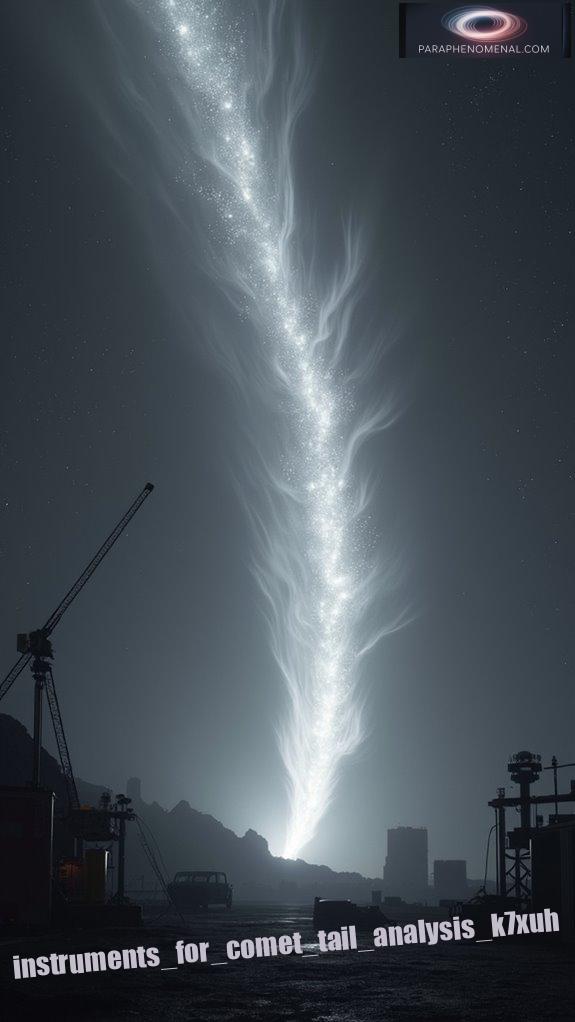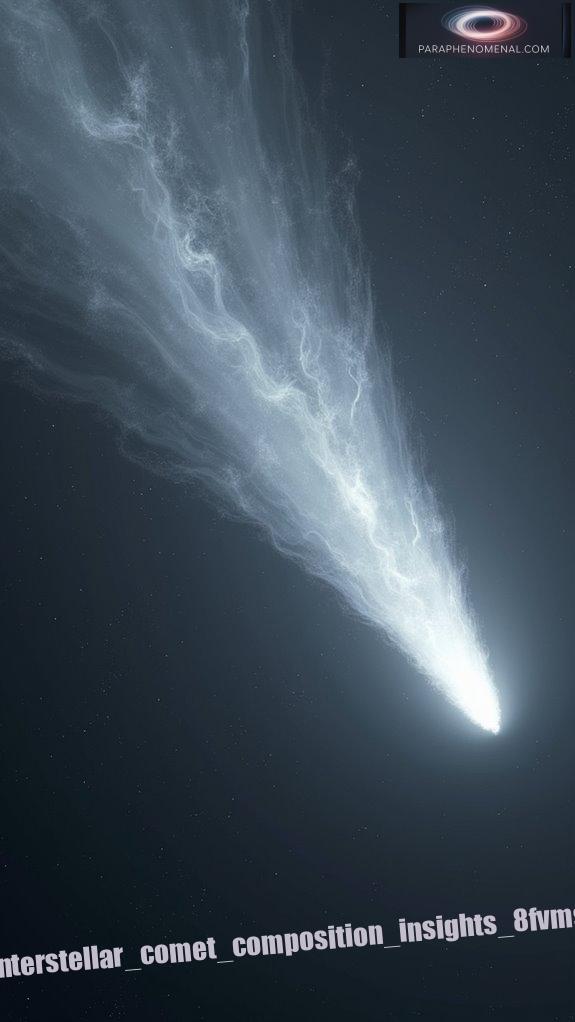Why do we venture into the ion tail of comet 3I/ATLAS?
The mysteries of the cosmos beckon us.
Crossing this ion tail could hold the key to understanding interstellar materials and how comets are born.
Shaped by solar winds, the tail reveals unique metallic compositions.
What could these secrets tell us about the universe’s origins?
As I delve into this fascinating field, I ponder the importance of studying plasma interactions and comet dynamics.
The challenges are daunting, yet the rewards could redefine our understanding of space.
Why not join me on this quest?
A Personal Encounter with Cosmic Wonders
Years ago, I stood beneath a brilliant night sky in Arizona, gazing at a meteor shower. I felt a connection to the cosmos, sparking my passion for UFO investigation. As I explored the trails of light, I noticed patterns and movements that felt otherworldly.
Each streak ignited questions about interstellar life and advanced technology. What if those meteors were signs of something much bigger?
This experience deepened my commitment to unraveling cosmic mysteries, particularly as they relate to UFO sightings and the dynamics of heavenly bodies. I realized that every comet and meteor is a piece of the vast universe puzzle.
Quick Takeaways
- Crossing the ion tail allows for direct analysis of its unique composition, particularly nickel and unusual volatiles like carbon monoxide and carbonyls.
- Observations during this crossing provide valuable data on plasma dynamics and interactions with solar wind, enhancing our understanding of cometary behavior.
- The ion tail’s proximity provides an opportunity to study tail formation processes and disconnection events critical for understanding comet evolution.
- Crossing the tail aids in testing navigation algorithms needed for future spacecraft missions, addressing real-time adjustments due to dynamic environments.
- Insights gained from studying the ion tail contribute to our understanding of interstellar materials, enriching knowledge of cosmic origins and process evolution.
Understanding Ion Tails in Comets

When you look at a comet, you might notice its stunning tails—especially the ion tail, which can tell us a lot about the comet’s environment and interactions with the Sun.
Ion tail formation begins when gas molecules sublimated from the comet nucleus become ionized by solar ultraviolet radiation. Once ionized, ions are swept away from the Sun, creating a nearly straight tail aligned with the solar wind. This process is influenced by the sublimation rates of gases released from the comet’s surface.
This ion tail dynamics reveal how the solar wind, moving much faster than the comet itself, shapes the tail’s structure. The bluish tint you see is often due to light emitted from ionized species. Additionally, variations in solar wind strength can significantly affect the structure and appearance of ion tails.
The Composition of Comet 3I/ATLAS
Comet 3I/ATLAS has a unique composition that sets it apart from typical Solar System comets.
Its metallic analysis reveals a gas plume rich in nickel but lacking iron, an imbalance not seen in other comets like 2I/Borisov. Spectroscopic evidence indicates nickel-carbonyl formation, a process rarely observed beyond Earth. Such cometary chemistry suggests diverse interstellar materials, possibly preserving pristine material from its parent stellar system. Recent observations have uncovered an anti-solar tail that further complicates its chemistry, supporting the idea of unusual chemical environments influencing its evolution.
You’ll find that 3I/ATLAS exhibits early sublimation of highly volatile ices, hinting at unusual components like carbon monoxide. This activity contributes to a diffuse coma obscuring views of the nucleus, reinforcing the idea that it’s no ordinary comet.
Observations from advanced telescopes, like Hubble, keep pushing our understanding of its foreign composition.
Significance of Ion Tail Interactions
Understanding the interactions between cometary ion tails and solar wind is pivotal for grasping how these cosmic bodies operate within our solar system.
The coupling creates dynamic plasma tails, sculpted by solar wind pressure. As solar wind particles meet cometary neutrals, you see plasma turbulence and electromagnetic oscillations come into play. These interactions exhibit twists and knots, reflecting varying solar wind conditions.
Disconnection events arise from shifts in magnetic field orientation, causing new tails to form. During these events, magnetic reconnection is observable, revealing key plasma processes.
As a result, cometary plasma tails serve as natural laboratories for studying the universe’s mysteries. Additionally, the unexplained phenomena accompanying these interactions may offer insights into potential UFO sightings linked to comet 3i/Atlas.
At ParaPhenomenal, we aim to explore these phenomena, enhancing our understanding of solar interactions and cosmic environments.
Scientific Instruments for Tail Analysis

Various scientific instruments play fundamental roles in analyzing the ion tails of comets, allowing researchers to gather valuable data about these fascinating cosmic features.
The Europa Clipper, for instance, is equipped with advanced instruments capable of plasma sampling and ion detection, making it crucial for understanding 3I/ATLAS’s ion tail. Mass spectrometers, ion detectors, and magnetometers will help reveal composition and behavior if conditions are favorable. Moreover, the peak activity is expected to coincide with the comet’s minimum distance from the Sun, providing an optimal opportunity for observations. Additionally, the NASA missions that focus on comets enhance our comprehension of the dynamic processes involved.
Ground-based telescopes like Keck II and Gemini South also contribute, using spectroscopy to identify chemical anomalies and provide a clearer picture of the tail’s structure.
These observations complement the findings from space telescopes, which monitor dust-loss rates and tail evolution. Exploring comet tails is essential in enhancing our knowledge of interstellar bodies and crafting future missions, like ours here at ParaPhenomenal.
Potential Discoveries From the Crossing
As you cross the ion tail of 3I/ATLAS, a world of potential discoveries awaits that could reshape our understanding of cometary science.
This mission might uncover unique dust particle dynamics, revealing how dust interacts in an interstellar environment, different from anything observed in our solar system.
You could find exotic molecules or isotopic ratios in the tail, offering perspectives into interstellar chemistry and ancient cosmic processes.
The chemical analysis of tail dust could also uncover the presence of organics or prebiotic materials, shedding light on the fundamental ingredients for life. Additionally, studying the ion tail composition can enhance our understanding of how cometary bodies evolve over time.
As we explore the mysteries of 3I/ATLAS, we contribute to the knowledge shared on our platform, ParaPhenomenal, igniting curiosity about the unfathomable dimensions of space.
Challenges of Spacecraft Navigation
Steering through the ion tail of comet 3I/ATLAS presents numerous challenges that demand exceptional precision and adaptability.
You’ll need to navigate uncertainties caused by solar gravity and ionized particles that can disrupt your sensors and thrusters.
Traditional navigation methods, relying on range and Doppler measurements, fall short as they can’t provide the lateral motion data you require.
You’ll depend on robust navigation algorithms to make necessary trajectory adjustments in real-time.
Deep space communication limitations remind you that delays can lead to missed opportunities for essential course corrections.
Autonomous systems come into play here, ensuring you can respond promptly.
The challenges are formidable, but the understanding awaiting you make every obstacle worthwhile, a focus of our journey here at ParaPhenomenal.
Insights Into Interstellar Origins

Understanding the origins of interstellar comets, like 3I/ATLAS, opens a window into the formation of our universe.
The unique compositions found in the ion tail reveal vital information about cometary evolution and interstellar chemistry. For instance, the elevated nickel levels signal complex metal-organic interactions seldom seen in solar system comets. Analyzing these materials highlights differences in formation processes and chemical diversity across star-forming regions.
Such findings enhance our understanding of the primordial interstellar medium, showing how materials evolve as they journey through space.
Future Missions and Exploration Possibilities
Exploring interstellar comets like 3I/ATLAS doesn’t just enrich our understanding of cosmic origins; it also opens up exciting possibilities for future missions and exploration.
Future missions could leverage low-energy trajectories to reach 3I/ATLAS, utilizing existing technology for high-speed flybys to gather essential data. With the comet reaching its perihelion in late 2025, mission timelines will need to align closely with its path for successful intercepts.
Future missions may harness low-energy paths to intercept 3I/ATLAS, aligning perfectly with its 2025 perihelion for critical data collection.
Target selection is imperative, as rapid adjustments will be necessary to meet the comet within a narrow timeframe. Instruments onboard future spacecraft, capable of quick data acquisition during close encounters, will help reveal understanding about interstellar materials.
Such missions not only advance science but resonate with our passion for discovering the wonders beyond our solar system.
FAQ
How Does Ion Tail Crossing Affect Spacecraft Safety?
Crossing an ion tail can put your spacecraft at risk in several ways.
The ionization effects may interfere with spacecraft navigation, causing signal fluctuations and affecting guidance systems.
Dust and gas exposure can induce electrostatic charging, which may lead to arcing and potential damage.
Furthermore, micrometeoroids from the tail can pose impact risks.
To guarantee safety, real-time monitoring and effective shielding are essential for protecting sensitive instruments during this thrilling journey.
What Historical Comets Have Had Similar Ion Tail Studies?
Historical comets like Halley’s Comet and Comet Hale-Bopp have been integral to ion tail studies.
Halley’s Comet clearly displayed the two-tail structure caused by solar wind, while Hale-Bopp revealed complex interactions between dust and ion tails.
Both demonstrated how solar forces shape tail dynamics, influencing spacecraft safety protocols.
As we explore these phenomena through projects like ParaPhenomenal, the revelations gained deepen our understanding of the mesmerizing dance of comets and their ion tails.
Are There Any Risks of Contamination From the Ion Tail?
Yes, there are risks of contamination from the ion tail.
The ion tail properties include charged particles that can interact with spacecraft materials, possibly causing ion contamination. Chemical reactions may occur between these particles and spacecraft components, leading to unexpected results.
There’s also electromagnetic interference that could disrupt electronics.
While it’s unlikely to pose a serious threat, being aware of these risks is essential when exploring such fascinating cosmic phenomena.
How Do Scientists Prepare for Unexpected Findings From the Ion Tail?
Scientists prepare for unexpected findings from the ion tail by emphasizing scientific adaptability and extensive data analysis. They equip spacecraft with advanced instruments to quickly capture and transmit data about various anomalies.
By developing protocols for rapid review, they guarantee that any unusual features are investigated thoroughly.
This adaptability in approach allows for a better understanding of the complexities surrounding comet observations, making certain that knowledge is continually updated and archived for future exploration.
What Technologies Are Used to Visualize Ion Tails in Space?
To visualize ion tails in space, scientists use advanced ion tail imaging techniques with spacecraft instrumentation.
Spacecraft like NASA’s SOHO and Rosetta capture detailed images from different angles, providing multi-spectral observations. Instruments measure charged particles in real-time while remote sensing tools detect emission lines, allowing a thorough understanding of a comet’s ion tail.
These methods enhance our knowledge of comets, leading to understandings that sometimes inspire projects like ParaPhenomenal, designed to explore celestial mysteries.
References
- https://arxiv.org/abs/2510.13222
- https://science.nasa.gov/missions/hubble/as-nasa-missions-study-interstellar-comet-hubble-makes-size-estimate/
- http://outreach.as.utexas.edu/marykay/highschool/CometTails.pdf
- https://www.rocketstem.org/2020/09/23/ice-and-stone-special-topic-39/
- https://www.walshmedicalmedia.com/open-access/comet-formation-and-dust-tail-suppression-mechanism.pdf
- https://adsabs.harvard.edu/full/1968ARA&A…6..267B
- https://thedebrief.org/3i-atlas-update-what-new-data-reveals-about-the-most-puzzling-interstellar-object-ever-found/
- https://www.spectroscopyonline.com/view/interstellar-comet-3i-atlas-shows-its-spectral-secrets-through-palomar-and-apache-point-observations
- https://www.skyatnightmagazine.com/news/3i-atlas-not-aliens
- https://news.northeastern.edu/2025/09/08/3i-atlas-comet-interstellar-traveler/
- https://www.seti.org/news/comet-3iatlas-a-visitor-from-beyond-the-solar-system/
- https://royalsocietypublishing.org/doi/10.1098/rsta.2016.0256
- https://ntrs.nasa.gov/api/citations/19800003724/downloads/19800003724.pdf
- https://agupubs.onlinelibrary.wiley.com/doi/full/10.1029/2024JA033623
- https://www.plasma-universe.com/comet/
- https://blogs.esa.int/rosetta/2015/07/29/rosetta-shows-how-comet-interacts-with-the-solar-wind/
- https://www.iflscience.com/two-spacecraft-to-fly-through-comet-3iatlass-ion-tail-will-they-be-able-to-catch-something-81195
- https://www.space.com/astronomy/scientists-capture-interstellar-invader-comet-3i-atlas-growing-a-tail-this-image-is-both-a-scientific-milestone-and-a-source-of-wonder-photo-video
- https://sites.psu.edu/astrowright/2025/09/29/3i-atlass-anti-tail-isnt-unique/
- https://futurism.com/space/interstellar-object-spraying-water
- https://www.livescience.com/space/comets/closest-view-yet-of-interstellar-comet-3i-atlas-captured-by-mars-orbiter
- https://en.wikipedia.org/wiki/3I/ATLAS
- https://www.youtube.com/watch?v=mwlTlw3rV5I
- https://science.nasa.gov/learn/basics-of-space-flight/chapter13-1/
- https://timeandnavigation.si.edu/navigating-space/challenges
- https://timeandnavigation.si.edu/navigating-space/deep-space
- https://stanfordasl.github.io/wp-content/papercite-data/pdf/Starek.Acikmese.ea.ACSTAA16.pdf
- https://arxiv.org/abs/2507.19921
- https://www.universetoday.com/articles/nasas-top-5-technical-challenges-countdown-4-improved-navigation
- https://www.iflscience.com/anti-tail-and-odd-594-kilometer-feature-found-on-interstellar-object-3iatlas-by-keck-observatory-81188
